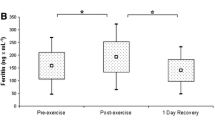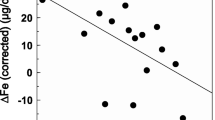Summary
Effects of endurance training on OZ transport and on iron status are well documented in the literature. Only a few data are available concerning the consequences of strenuous anaerobic muscular exercise on red cell function. This study was performed to test the influence of strength training alone on parameters of red cell O2 transport and iron status. Twelve healthy untrained males participated in a strength-training pro gramme of 2-h sessions four times a week lasting 6 weeks. After 6 weeks a small but significant reduction of haemoglobin (Hb; − 5.4 g·l−1) was found (p<0.05). Mean red cell volume did not change, but a pronounced decrease of mean cell Hb concentration (from 329.2g·l−1, SE 2.5 to 309.8g·l−1, SE 1.2;p<0.001) and mean corpuscular Hb (from 29.6 pg, SE 0.4 to 27.7 pg, SE 0.3;p<0.01) was observed. Serum ferritin decreased significantly by 35% (p<0.01); transferrin, serum iron and iron saturation of transferrin were unaltered. Serum haptoglobin concentration was diminished significantly by 30.5% (p<0.01). The reticulocyte count had already increased after 3 weeks of training (p<0.05) and remained elevated during the following weeks. Strength training had no significant influence on the O2 partial pressure at which Hb under standard conditions was 50% saturated, red cell 2,3-diphospho glycerate and ATP concentration as well as on erythrocytic glutamate-oxalacetate transaminase activity. The data demonstrate that mechanical stress of red cells due to the activation of large muscle masses led to increased intravascular haemolysis, accompanied by a slightly elevated erythropoiesis, which had no detectable influence on Hb-O2 affinity. Training caused an initial depletion of body iron stores (prelatent iron deficiency). Although Hb had decreased by the end of the training phase a true “sports anaemia” could not be detected.
Similar content being viewed by others
References
Astrup P, Engel K, Severinghaus JW (1956) The influence of temperature and pH on the dissociation curve of oxyhemoglobin of human blood. Scand J Clin Lab Invest 17:515–523
Beutler E (1975) Red cell metabolism. Grime and Stratton, New York
Böning D, Schweigart U, Tibes U, Hemmer B (1975) Influences of exercise and endurance training on the oxygen dissociation curve of blood under in vivo and in vitro conditions. Eur J Appl Physiol 34:1–10
Brodthagen U, Hansen KU, Knudsen JB, Jordal R, Kristensen O, Paulev PE (1985) Red cell 2,3-DPG, ATP and mean cell volume in highly trained athletes. Eur J Appl Physiol 53:334–338
Brotherhood J, Brozovic B, Pugh LGC (1975) Haematological status of middle- and long-distance runners. Clin Sci 48:139–145
Clement DB, Sawchuk LL (1984) Iron status and sports performance. Sports Med 1:65–74
Convertino VA, Brock P, Keil LC, Bernauer EM, Greenleaf JE (1980) Exercise training-induced hypervolemia: role of plasma albumin, renin, and vasopressin. J Appl Physiol 48:665–669
Cook JD (1982) Clinical evaluation of iron deficiency. Semin Hematol 19:6–18
Davies GJ (1985) A compendium of isokinetics in clinical usage. S and S, La-Crosse, Wis., USA
Dufaux B, Hoederath A, Streitberger I, Hollmann W, Assmann G (1981) Serum ferritin, transferrin, haptoglobin, and iron in middle- and long-distance runners, elite rowers, and professional racing cyclists. Int J Sports Med 2:43–46
Ehn L, Carlmark B, Höglund S (1980) Iron status in athletes involved in intense physical activity. Med Sci Sports Exerc 12:61–64
Finch CA, Gollnick PD, Hlastala MP, Miller LR, Dillmann E, Mackler B (1979) Lactic acidosis as a result of iron deficiency. J Clin Invest 64:129–137
Fisher I, Walter H (1971) Aspartate aminotransferase (GOT) from young and old erythrocytes. J Lab Clin Med 78:736–745
Hasibeder W, Schobersberger W, Mairbäurl H (1987) Red Cell oxygen transport before and after short-term maximal swimming in dependence on training status. Int J Sports Med 8:105–108
Heinrich HC, Burggemann J, Gabbe EE, Glaser M (1977) Correlation between diagnostic Fe-absorption and serum ferritin concentration in man. Z Naturforsch 32:1023–1025
Holmgren A, Mossfeldt F, Sjöstrand T, Ström G (1960) Effect of training on work capacity, total hemoglobin, blood volume, heart volume and pulse rate in recumbent and upright position. Acta Physiol Scand 50:72–83
Hunding A, Jordal R, Paulev PE (1981) Runner's anemia and iron deficiency. Acta Med Scand 209:315–318
Katz A, Sharp RL, King DS, Costill DL, Fink WJ (1984) Effect of high intensity interval training on 2,3-diphosphoglycerate at rest and after maximal exercise. Eur J Appl Physiol 52:331–335
Kjellberg SR, Ruhde U, Sjöstrand T (1949) Increase of the amount of hemoglobin and blood volume in connection with physical training. Acta Physiol Scand 19:146–151
Lindemann R (1978) Low hematocrits during basic training: athletes anemia? N Engl J Med 299:1191–1192
Lipschitz DA, Cook JD, Finch C (1974) A clinical evaluation of serum ferritin as an index of iron stores. N Engl J Med 290:1213–1216
Magazanik A, Weinstein Y, Dlin RA, Derin M, Schwartzman S, Allalouf D (1988) Iron deficiency caused by 7 weeks of intensive physical exercise. Eur J Appl Physiol 57:198–202
Mairbaurl H, Schobersberger W, Humpeler E, Hasibeder W, Fischer W, Raas E (1986) Beneficial effects of exercising at moderate altitude on red cell oxygen transport and on exercise performance. Pflügers Arch 406:594–599
Mancini G, Carbonara AO, Heremans JF (1965) Immunochemical quantitation of antigens by single radial immunodiffusion. Immunochemistry 2:235
Nilson K, Schoene RB, Robertson HD, Escourrou P, Smith NJ (1981) The effect of iron repletion on exercise-induced lactate production in minimally iron-deficient subjects. Med Sci Sports Exerc 13:92–96
Pate RR (1983) Sports anemia: a review of the current research literature. Phys Sportsmed 11:115–131
Paulev PE, Jordal R, Strandberg Petersen N (1983) Dermal excretion of iron in intensely training athletes. Clin Chim Acta 127:19–27
Rand PW, Norton JM, Barker N, Lovell M (1973) Influence of athletic training on hemoglobin-oxygen affinity. Am J Physiol 224:1334–1337
Remes K (1979) Effect of long-term physical training on total red cell volume. Scand J Clin Lab Invest 39:311–319
Röcker L, Kirsch KA, Stoboy H (1976) Plasma volume, albumin and globulin concentrations and their intravascular masses. Eur J Appl Physiol 36:57–64
Schmidt W, Maassen N, Trost F, Böning D (1988) Training induced effects on blood volume, erythrocyte turnover and haemoglobin oxygen binding properties. Eur J Appl Physiol 57:490–498
Siegel AJ, Hennekens CH, Solomon HS, Van Boeckel B (1979) Exercise related hematuria. JAMA 241:391–392
Stewart JG, Ahlquist DA, McGill DB, Ilstrup DM, Schwartz S, Owen RA (1984) Gastrointestinal blood loss and anemia in runners. Ann Intern Med 100:843–845
Veicsteinas A, Samaja M, Gussoni M, Cerretelli P (1984) Blood O2 affinity and maximal O2 consumption in elite bicycle racers. J Appl Physiol 57:52–58
Yoshimura H, Inoue T, Yamada T, Shiraki K (1980) Anemia during hard physical training (sports anemia) and its causal mechanisms with special reference to protein nutrition. World Rev Nutr Diet 35:1–86
Author information
Authors and Affiliations
Rights and permissions
About this article
Cite this article
Schobersberger, W., Tschann, M., Hasibeder, W. et al. Consequences of 6 weeks of strength training on red cell O2 transport and iron status. Europ. J. Appl. Physiol. 60, 163–168 (1990). https://doi.org/10.1007/BF00839152
Accepted:
Issue Date:
DOI: https://doi.org/10.1007/BF00839152




